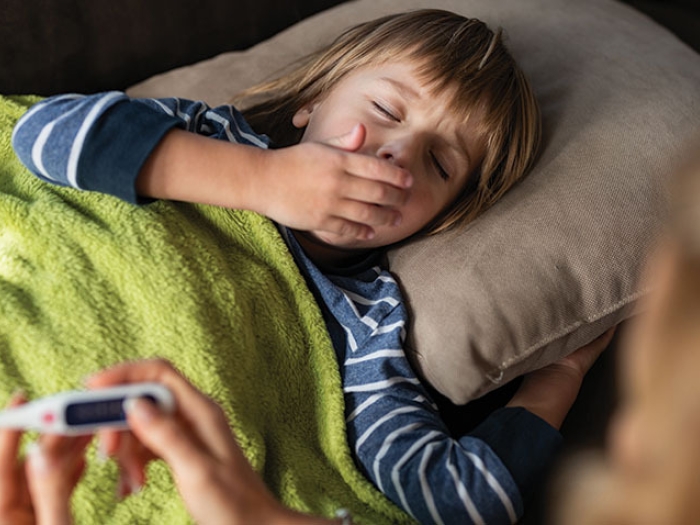Is it contagious? When should parents worry? What to know before heading to the E.R or doctor.
5:00 AM
Author |

Croup is one of the most common and distinctive viral infections in young children. Characterized by a hoarse voice or cry, a barking cough, and an audible breathing sound called stridor, croup is easily diagnosed and treated.
Most cases are mild, but occasionally croup can cause serious breathing difficulty in babies and small children, which in some cases require hospitalization. In fact, up to 6% of children with croup need hospitalization, according to an article in American Family Physician.
MORE FROM MICHIGAN: Sign up for our weekly newsletter
To better understand croup, why it happens and when it requires special medical attention, an expert answers some common questions.
What is croup in babies?
"Croup is a swelling of the voice box just below the vocal cords typically caused by a viral infection," explained Erin Kirkham, M.D., MPH, a pediatric otolaryngologist at University of Michigan Health C.S. Mott Children's Hospital.
In very rare cases, there may be other underlying causes.
"At baseline, any abnormality that narrows the airway can increase croup symptoms in a child with a virus. Allergies and reflux can also worsen that situation," Kirkham said. "And although rare, some children can be born with a narrow airway or a mass in that area that can predispose them to recurrent or more severe cases of croup."
Can COVID-19 cause croup?
Children under 5 who recently had the Omicron variant of COVID-19 presented with symptoms of croup, like a barking cough.
Even prior to the emergence of Omicron, there were reports that the SARS-CoV-2 virus caused croup in some children. One journal detailed the case of a 14-month-old boy whose croup was caused by COVID-19, in which the authors noted it was not "unprecedented" since other coronaviruses have "previously been shown to cause croup."
As new variants emerge, parents of children with croup-like symptoms should be aware of the connection.
"If your child has croup and may have been exposed to COVID, you should consider testing for COVID-19," Kirkham said.
COVID-19 may also be contributing to more frequent croup cases caused by other viruses. With the pandemic keeping kids at home, many weren't exposed to germs and missed a window of immune development, Kirkham says. Now that more kids are back in school and daycare, cases of common childhood viruses like croup and RSV have spiked.
What are the treatments for croup?
There are a range of treatments for croup, starting with home remedies. Home remedies for croup include:
-
Acetaminophen (like Tylenol)
-
Ibuprofen if the child is over six months old
-
Steam to help the cough and stridor
-
Going out in cold air for a brief period of time to reduce inflammation
At a physician's office, a child will sometimes be treated with oral or inhaled steroids.
"An inhaled treatment called racemic epinephrine can also decrease airway swelling and provide pretty quick relief," Kirkham said.
Occasionally, croup can turn severe, and a child might need supplemental oxygen in the hospital.
If a child is breathing fast, has tugging of the skin under their ribs or at the collarbones while breathing, or the stridor worsens, parents should seek medical attention right away—an immediate visit to a pediatrician or urgent care, or even the emergency room, depending on the severity and time of day.
Is croup contagious?
The viruses that cause croup are contagious, but the barking cough and stridor symptoms aren't necessarily catching.
"Kids with croup are considered contagious for three days after the illness or until the fever is gone," Kirkham said.
Can adults get croup?
Croup is considered a childhood illness. Adults can easily catch the same viruses that cause croup in children. But because adults have bigger airways, adults don't get the barking cough and stridor that characterizes croup in children.
"The reason croup happens in kids and not adults is that children have a smaller airway," Kirkham said. The same virus in an older person may look like the common cold or a case of laryngitis.
In children, croup can occur any time from babyhood up through 12 years of age. It is most common around age 2—as children grow, they age out of the symptoms, Kirkham says.
What is recurrent croup?
If a school-aged child is still developing the hallmark symptoms of croup, or if a child gets croup more than twice in a year—a condition known as recurrent croup—that may require a visit to a specialist. A pediatric otolaryngologist like Kirkham can examine a child to see if there's an underlying airway problem.
Risk factors for recurrent croup include a past history of intubation for any reason and a history of prematurity. Many premature babies have to be intubated for a period of time while their lungs mature, and this can increase the likelihood of abnormal findings in a recurrent croup case, Kirkham says.
"Otolaryngologists can screen children for something out of the ordinary going on. For example, am I concerned that there's a mass there? Or that a child might have an abnormally narrow voice box or trachea?" Kirkham said. "I take a history and really try to determine what's going on."
"Often we will use a flexible scope through the nose in clinic while the child is awake. That doesn't allow us to directly examine the area affected by croup, but it allows us to screen for other things above the area and look at the mobility of the vocal cords."
In rare occasions, a pediatric otolaryngologist will perform a bronchoscopy under anesthesia in an OR to screen for masses in the throat or structural abnormalities that can be acted upon. Kirkham performs bronchoscopies selectively—less than 10 percent of bronchoscopies for recurrent croup find anything abnormal. She's careful to weigh the risks and benefits of this procedure in each child.
"Overall, what we are looking for is those few patients out of 100 with recurrent croup that might have a mass or a narrowing that we can intervene upon and change their course," Kirkham said.
How can croup be prevented?
Croup is prevented just like any other viral illness—handwashing, social distancing, keeping kids home from school or daycare if they're sick with symptoms that may spread to others. Frequent cleaning may help viruses from spreading in daycare or school environments.
Unfortunately for many families, croup is just a part of early childhood. But with proper monitoring and care, in most cases, it can be quickly treated, and a child can safely resume normal life.
Like Podcasts? Add the Michigan Medicine News Break on iTunes, Google Podcasts or anywhere you listen to podcasts.

Explore a variety of health care news & stories by visiting the Health Lab home page for more articles.

Department of Communication at Michigan Medicine
Want top health & research news weekly? Sign up for Health Lab’s newsletters today!





